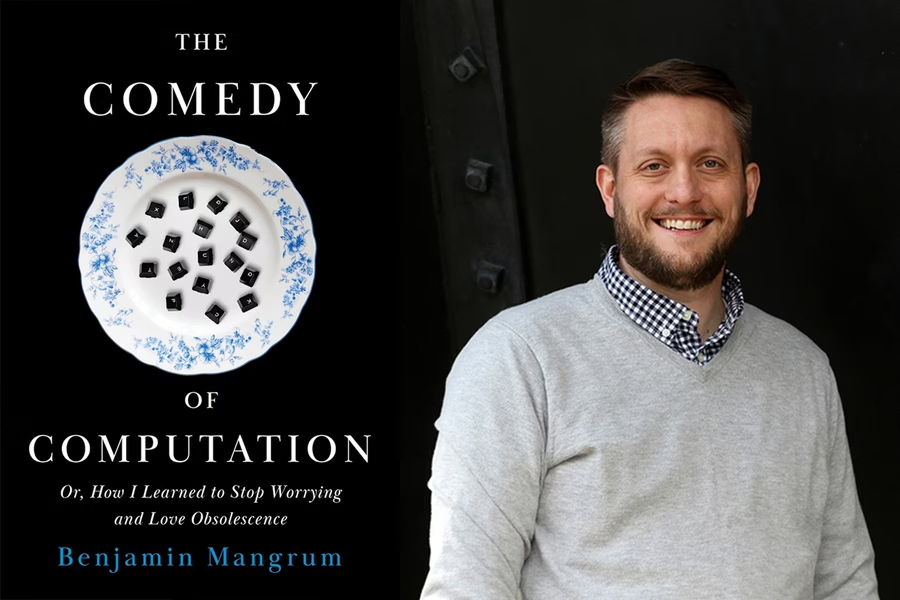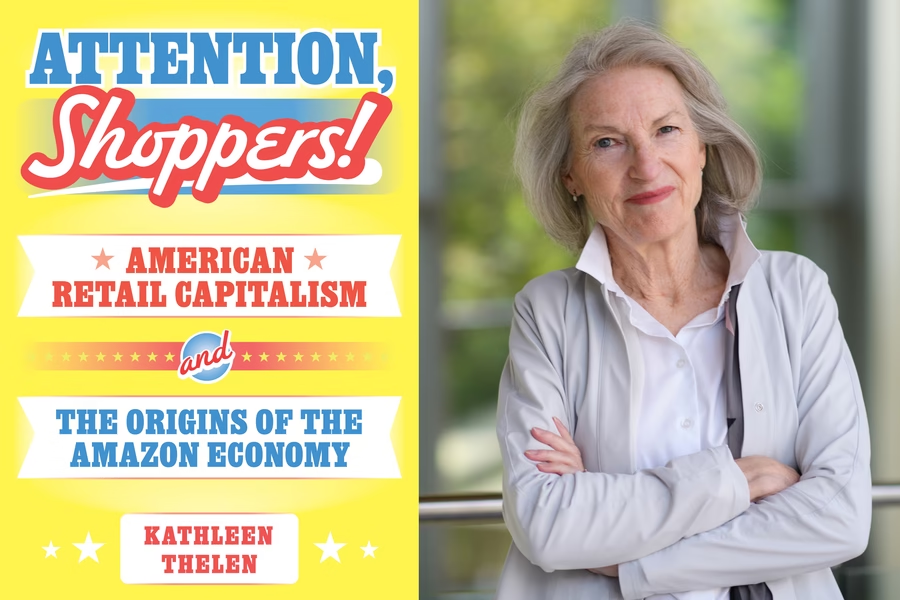Books
Humour, Humanity, and the Machine: A New Book Explores Our Comic Relationship with Technology
MIT scholar Benjamin Mangrum examines how comedy helps us cope with, critique, and embrace computing.

In a world increasingly shaped by algorithms, automation, and artificial intelligence, one unexpected tool continues to shape how we process technological change: comedy.
That’s the central argument of a thought-provoking new book by MIT literature professor Benjamin Mangrum, titled The Comedy of Computation: Or, How I Learned to Stop Worrying and Love Obsolescence, published this month by Stanford University Press. Drawing on literature, film, television, and theater, Mangrum explores how humor has helped society make sense of machines-and the humans who build and depend on them.
“Comedy makes computing feel less impersonal, less threatening,” Mangrum writes. “It allows us to bring something strange into our lives in a way that’s familiar, even pleasurable.”
From romantic plots to digital tensions
One of the book’s core insights is that romantic comedies-perhaps surprisingly-have been among the richest cultural spaces for grappling with our collective unease about technology. Mangrum traces this back to classic narrative structures, where characters who begin as obstacles eventually become partners in resolution. He suggests that computing often follows a similar arc in cultural storytelling.
“In many romantic comedies,” Mangrum explains, “there’s a figure or force that seems to stand in the way of connection. Over time, that figure is transformed and folded into the couple’s union. In tech narratives, computing sometimes plays this same role-beginning as a disruption, then becoming an ally.”
This structure, he notes, is centuries old-prevalent in Shakespearean comedies and classical drama-but it has found renewed relevance in the digital age.
Satirizing silicon dreams
In the book, Mangrum also explores what he calls the “Great Tech-Industrial Joke”-a mode of cultural humor aimed squarely at the inflated promises of the technology industry. Many of today’s comedies, from satirical shows like Silicon Valley to viral social media content, lampoon the gap between utopian tech rhetoric and underwhelming or problematic outcomes.
“Tech companies often announce revolutionary goals,” Mangrum observes, “but what we get is just slightly faster email. It’s a funny setup, but also a sharp critique.”
This dissonance, he argues, is precisely what makes tech such fertile ground for comedy. We live with machines that are both indispensable and, at times, disappointing. Humor helps bridge that contradiction.
The ethics of authenticity
Another recurring theme in The Comedy of Computation is the modern ideal of authenticity, and how computing complicates it. From social media filters to AI-generated content, questions about what’s “real” are everywhere-and comedy frequently calls out the performance.
“Comedy has always mocked pretension,” Mangrum says. “In today’s context, that often means jokes about curated digital lives or artificial intelligence mimicking human quirks.”
Messy futures, meaningful laughter
Ultimately, Mangrum doesn’t claim that comedy solves the challenges of computing-but he argues that it gives us a way to live with them.
“There’s this really complicated, messy picture,” he notes. “Comedy doesn’t always resolve it, but it helps us experience it, and sometimes, laugh through it.”
As we move deeper into an era of smart machines, digital identities, and algorithmic decision-making, Mangrum’s book reminds us that a well-placed joke might still be one of our most human responses.
(With inputs from MIT News)
Books
The Rise of U.S. Retail Giants: A Century of Political and Economic Shaping
Currently, 90% of Americans live within 10 miles of a Walmart, and five of the top 10 U.S. employers—Walmart, Amazon, Home Depot, Kroger, and Target—are retailers

The U.S. retail sector, once dominated by small, independent merchants, has transformed over the past century into a landscape controlled by retail giants. In the late 19th century, most U.S. retail was local. However, this shifted with the rise of catalog retailers like Sears and Roebuck, which saw rapid growth, followed by Montgomery Ward’s expansion. By the 1930s, chain stores began to proliferate, with the Atlantic and Pacific (A&P) supermarkets leading the pack with over 15,000 locations.
Fast-forward to today, and the dominance of retailers like Walmart, Amazon, and Target is undeniable. Currently, 90% of Americans live within 10 miles of a Walmart, and five of the top 10 U.S. employers—Walmart, Amazon, Home Depot, Kroger, and Target—are retailers. In addition, logistics giants UPS and FedEx play a crucial role in supporting the retail economy.
This prevalence of massive retail chains is largely unique to the U.S., where domestic consumption is a driving force behind economic growth. Additionally, the U.S. has five times as much retail space per capita as Japan and the U.K., and 10 times as much as Germany. Unlike in Europe, the U.S. has few regulations limiting shopping hours.
How did we arrive at this point? While major chains like Walmart and Amazon are known for their business prowess, the full story involves over a century of political and legal debates that shaped the landscape of U.S. retailing. MIT political scientist Kathleen Thelen, in her new book Attention, Shoppers! American Retail Capitalism and the Origins of the Amazon Economy, dives into the role of political and legal forces in the rise of large, low-cost retailers.
“The markets that we take as given, that we think of as the natural outcome of supply and demand, are heavily shaped by policy and by politics,” Thelen explains.
Thelen’s book offers a unique perspective, drawing comparisons with European economies and taking a historical approach to the growth of chain retailing. For instance, she highlights how alternative commercial arrangements, like cooperatives, were stifled by U.S. antitrust laws, which favored big corporations while suppressing smaller competitors. This legal framework gave a significant advantage to large retailers, including Sears, which relied on the U.S. Postal Service’s money order system to reach customers who lacked bank accounts.
Smaller retailers resisted the expansion of large chains, particularly during the Great Depression, but big retailers found ways around regulatory constraints. “Antitrust laws in the United States were very forbearing toward big multidivisional corporations and very punitive toward alternative types of arrangements like cooperatives, so big retailers got a real boost in that period,” Thelen says. Over time, antitrust law increasingly prioritized consumer prices, further benefiting low-cost retailers.
As Thelen argues, prioritizing price reduction often leads to lower wages for workers, with large retailers driving down wages both directly and through pressure on suppliers. “If you prioritize prices, one of the main ways to reduce prices is to reduce labor costs,” she says, noting that low-cost discounters are often low-wage employers.
In her analysis, Thelen suggests that the American retail system’s focus on low prices, low wages, and high consumer convenience has led to a “deep equilibrium,” where low-wage workers rely on these retail giants to make ends meet. Meanwhile, the speed of modern delivery systems has become a normal part of American shopping culture.
“The triumph of these types of retailers was not inevitable,” Thelen reflects. “It was a function of politics and political choice.” With ongoing debates about labor law reforms and antitrust enforcement, the current retail equilibrium may persist for the foreseeable future, unless significant changes are made to the system.
Through Attention, Shoppers!, Thelen offers readers a comprehensive look at the economic forces that have shaped the retail sector, helping explain the giant retail landscape many Americans take for granted today.
-

 Space & Physics5 months ago
Space & Physics5 months agoIs Time Travel Possible? Exploring the Science Behind the Concept
-

 Earth6 months ago
Earth6 months ago122 Forests, 3.2 Million Trees: How One Man Built the World’s Largest Miyawaki Forest
-

 Space & Physics6 months ago
Space & Physics6 months agoDid JWST detect “signs of life” in an alien planet?
-

 Know The Scientist5 months ago
Know The Scientist5 months agoNarlikar – the rare Indian scientist who penned short stories
-

 Society4 months ago
Society4 months agoShukla is now India’s first astronaut in decades to visit outer space
-

 Society4 months ago
Society4 months agoAxiom-4 will see an Indian astronaut depart for outer space after 41 years
-

 Earth4 months ago
Earth4 months agoWorld Environment Day 2025: “Beating plastic pollution”
-

 Society6 months ago
Society6 months agoRabies, Bites, and Policy Gaps: One Woman’s Humane Fight for Kerala’s Stray Dogs












